Kathmandu Durbar Square
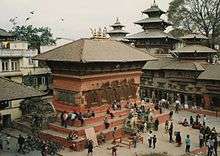



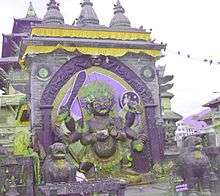
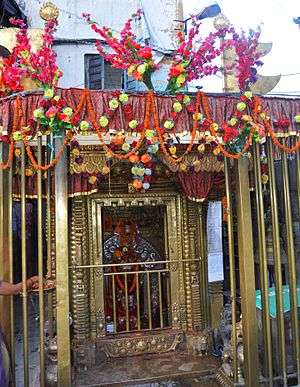

Kathmandu Durbar Square (Basantapur Darbar Kshetra) in front of the old royal palace of the former Kathmandu Kingdom is one of three Durbar (royal palace) Squares in the Kathmandu Valley in Nepal, all of which are UNESCO World Heritage Sites.
Several buildings in the Square collapsed due to a major earthquake on 25 April 2015. Durbar Square was surrounded with spectacular architecture and vividly showcases the skills of the Newar artists and craftsmen over several centuries. The Royal Palace was originally at Dattaraya square and was later moved to the Durbar square.[1]
The Kathmandu Durbar Square held the palaces of the Malla and Shah kings who ruled over the city. Along with these palaces, the square surrounds quadrangles, revealing courtyards and temples. It is known as Hanuman Dhoka Durbar Square, a name derived from a statue of Hanuman, the monkey devotee of Lord Ram, at the entrance of the palace.
History and construction
The preference for the construction of royal palaces at this site dates back to as early as the Licchavi period in the third century. Even though the present palaces and temples have undergone repeated and extensive renovations and nothing physical remains from that period. Names like Gunapo and Gupo, which are the names referred to the palaces in the square in early scriptures, imply that the palaces were built by Gunakamadev, a King ruling late in the tenth-century. When Kathmandu City became independent under the rule of King Ratna Malla (1484–1520), the palaces in the square became the Royal Palaces for its Malla Kings. When Prithvi Narayan Shah invaded the Kathmandu Valley in 1769, he favored the Kathmandu Durbar Square for his palace. Other subsequent Shah kings continued to rule from the square until 1896 when they moved to the Narayan Hiti Palace.
The square is still the center of important royal events like the coronation of King Birendra Bir Bikram Shah in 1975 and King Gyanendra Bir Bikram Shah in 2001.
Though there are no written archives stating the history of Kathmandu Durbar Square, construction of the palace in the square is credited to Sankharadev (1069–1083). As the first king of the independent Kathmandu City, Ratna Malla is said to have built the Taleju temple in the Northern side of the palace in 1501. For this to be true then the temple would have had to have been built in the vihara style as part of the palace premise surrounding the Mul Chok courtyard for no evidence of a separate structure that would match this temple can be found within the square.
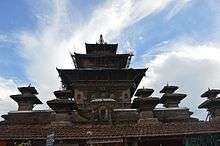
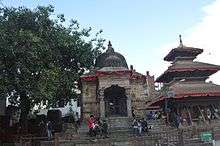
Construction of the Kernel Chok is not clearly stated in any historical inscriptions; although, it is probably the oldest among all the courtyards in the square. The Bhagavati Temple, originally known as a Narayan Temple, rises above the mansions surrounding it and was added during the time of Jagajaya Malla in the early eighteenth century. The Narayan idol within the temple was stolen so Prithvi Narayan Shah replaced it with an image of Bhagavati, completely transforming the name of the temple.
The oldest temples in the square are those built by Mahendra Malla (1560–1574). They are the temples of Jagannath, Kotilingeswara Mahadev, Mahendreswara, and the Taleju Temple. This three-roofed Taleju Temple was established in 1564, in a typical Newari architectural style and is elevated on platforms that form a pyramid-like structure. It is said that Mahendra Malla when he was residing in Bhaktapur, was highly devoted to the Taleju Temple there; the Goddess being pleased with his devotion gave him a vision asking him to build a temple for her in the Kathmandu Durbar Square. With a help of a hermit, he designed the temple to give it its present form and the Goddess entered the temple in the form of a bee.
His successors Sadasiva (1575–1581), his son, Shiva Simha (1578–1619), and his grandson, Laksmi Narsingha (1619–1641), do not seem to have made any major additions to the square. During this period of three generations, the only constructions to have occurred were the establishment of Degutale Temple dedicated to Goddess Mother Taleju by Shiva Simha and some enhancement in the royal palace by Laksminar Simha.
Under Pratap Malla
In the time of Pratap Malla, son of Laksminar Simha, the square was extensively developed. He was an intellectual, a pious devotee, and especially interested in arts. He called himself a Kavindra, king of poets, and boasted that he was learned in fifteen different languages. A passionate builder, following his coronation as a king, he immediately began enlargements to his royal palace, and rebuilt some old temples and constructed new temples, shrines, and stupas around his kingdom.
_and_Vishnu_Temple_(right)_at_the_Kathmandu_Durbar_Square-Nepal.jpg)
During the construction of his palace, he added a small entrance in the traditional, low and narrow Newari style. The door was elaborately decorated with carvings and paintings of deities and auspicious signs and was later transferred to the entrance of Mohan Chok. In front of the entrance, he placed the statue of Hanuman thinking that Hanuman would strengthen his army and protect his home. The entrance leads to Nasal Chok, the courtyard where most royal events such as coronation, performances, and yagyas, holy fire rituals, take place. It was named after Nasadya, the God of Dance, and during the time of Pratap Malla the sacred mask dance dramas performed in Nasal Chok were widely famed. In one of these dramas, it is said that Pratap Malla himself played the role of Lord Vishnu and that the spirit of the Lord remained in the king's body even after the play. After consulting his Tantric leaders, he ordered a stone image of Lord Vishnu in his incarnation as Nara Simha, the half-lion, and half-human form, and then transferred the spirit into the stone. This fine image of Narasimha made in 1673 still stands in the Nasal Chok. In 1650, he commissioned for the construction of Mohan Chok in the palace. This chok remained the royal residential courtyard for many years and is believed to store a great amount of treasure under its surface. Pratap Malla also built Sundari Chok about this time. He placed a slab engraved with lines in fifteen languages and proclaimed that he who can understand the inscription would produce the flow of milk instead of water from Tutedhara, a fountain set in the outer walls of Mohan Chok. However elaborate his constructions may have been, they were not simply intended to emphasize his luxuries but also his and the importance of others' devotion towards deities. He made extensive donations to temples and had the older ones renovated. Next, to the palace, he built a Krishna temple, the Vamsagopala, in an octagonal shape in 1649. He dedicated this temple to his two Indian wives, Rupamati and Rajamati, as both had died during the year it was built. In Mohan Chok, he erected a three roofed Agamachem temple and a unique temple with five superimposing roofs. After completely restoring the Mul Chok, he donated to the adjoining Taleju Temple. To the main temple of Taleju, he donated metal doors in 1670. He rebuilt the Degutale Temple built by his grandfather, Siva Simha, and the Taleju Temple in the palace square. As a substitute to the Indreswara Mahadeva Temple in the distant village of Panauti, he built a Shiva temple, Indrapura, near his palace in the square. He carved hymns on the walls of the Jagannath Temple as prayers to Taleju in the form of Kali.
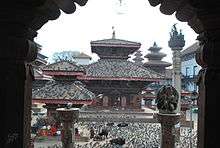
At the southern end of the square, near Kasthamandap at Maru, which was the main city crossroads for early traders, he built another pavilion named Kavindrapura, the mansion of the king of poets. In this mansion, he set an idol of dancing Shiva, Nasadyo, which today is highly worshiped by dancers in the Valley.
In the process of beautifying his palace, he added fountains, ponds, and baths. In Sundari Chok, he established a low bath with a golden fountain. He built a small pond, the Naga Pokhari, in the palace adorned with Nagakastha, a wooden serpent, which is said he had ordered stolen from the royal pond in the Bhaktapur Durbar Square. He restored the Licchavi stone sculptures such as the Jalasayana Narayana, the Kaliyadamana, and the Kala Bhairav. An idol of Jalasayana Narayana was placed in a newly created pond in the Bhandarkhal garden in the eastern wing of the palace. As a substitute to the idol of Jalasayana Narayana in Buddhanilkantha, he channeled water from Buddhanilkantha to the pond in Bhandarkhal due bestow authenticity. The Kalyadana, a manifestation of Lord Krishna destroying Kaliya, a water serpent, is placed in Kalindi Chok, which is adjacent to the Mohan Chok. The approximately ten-feet-high image of terrifyingly portrayed Kal Bhairav is placed near the Jagannath Temple. This image is the focus of worship in the chok, especially during Durga Puja.
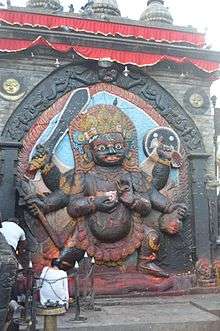
With the death of Pratap Malla in 1674, the overall emphasis on the importance of the square came to a halt. His successors retained relatively insignificant power and the prevailing ministers took control of most of the royal rule. The ministers encountered little influence under these kings and, increasingly, the interest of the arts and additions to the square was lost on them. They focused less on culture than Pratap Malla during the three decades that followed his death, steering the city and country more towards the arenas of politics and power, with only a few minor constructions made in the square. These projects included Parthivendra Malla building a temple referred to as Trailokya Mohan or Dasavatara, dedicated to Lord Vishnu in 1679. A large statue of Garuda, the mount of Lord Vishnu, was added in front of it a decade later. Parthivendra Malla added a pillar with an image of his family in front of the Taleju Temple.
Around 1692, Radhilasmi, the widowed queen of Pratap Malla, erected the tall temples of Shiva known as Maju Deval near the Garuda image in the square. This temple stands on nine stepped platforms and is one of the tallest buildings in the square. Then her son, Bhupalendra Malla, took the throne and banished the widowed queen to the hills. His death came early at the age of twenty-one and his widowed queen, Bhuvanalaksmi, built a temple in the square known as Kageswara Mahadev. The temple was built in the Newari style and acted as a substitute for worship of a distant temple in the hills. After the earthquake in 1934, the temple was restored with a dome roof, which was alien to the Newari architecture.
Jayaprakash Malla, the last Malla king to rule Kathmandu, built a temple for Kumari and Durga in her virginal state. The temple was named Kumari Bahal and was structured like a typical Newari vihara. In his house resides the Kumari, a girl who is revered as the living goddess. He also made a chariot for Kumari and in the courtyard had detailed terra cotta tiles of that time laid down.
Under the Shah dynasty
During the Shah dynasty that followed, the Kathmandu Durbar Square saw a number of changes. Two of the most unusual temples in the square were built during this time. One is the Nautale, a nine-storied building known as Basantapur Durbar. It has four roofs and stands at the end of Nasal Chok at the East side of the palace. It is said that this building was set as a pleasure house. The lower three stories were made in the Newari farmhouse style. The upper floors have Newari style windows, sanjhya and tikijhya, and some of them are slightly projected from the wall. The other temple is annexed to the Vasantapur Durbar and has four stories. This building was initially known as Vilasamandira, or Lohom Chok, but is now commonly known as Basantapur or Tejarat Chok. The lower floors of the Basantapur Chok display extensive woodcarvings and the roofs are made in popular the Mughal style. Archives state that Prthivi Narayan Shah built these two buildings in 1770.
Rana Bahadur Shah was enthroned at the age of two. Bahadur Shah, the second son of Prithvi Narayan Shah, ruled as a regent for his young nephew Rana Bahadur Shah for a close to a decade from 1785 to 1794 and built a temple of Shiva Parvati in the square. This one roofed temple is designed in the Newari style and is remarkably similar to previous temples built by the Mallas. It is rectangular in shape and enshrines the Navadurga, a group of goddesses, on the ground floor. It has a wooden image of Shiva and Parvati at the window of the upper floor, looking out at the passersby in the square. Another significant donation made during the time of Rana Bahadur Shah is the metal-plated head of Swet Bhairav near the Degutale Temple. It was donated during the festival of Indra Jatra in 1795 and continues to play a major role during the festival every year. This approximately twelve feet high face of Bhairav is concealed behind a latticed wooden screen for the rest of the year. The following this donation Rana Bahadur donated a huge bronze bell as an offering to the Goddess Taleju. Together with the beating of the huge drums donated by his son Girvan Yudha, the bell was rung every day during the daily ritual worship to the goddess. Later these instruments were also used as an alarm system. However, after the death of his beloved third wife Kanimati Devi due to smallpox, Rana Bahadur Shah turned mad with grief and had many images of gods and goddesses smashed including the Taleju statue and bell, and Sitala, the goddess of smallpox.
In 1908, a palace, Gaddi Durbar, was built using European architectural designs. The Rana Prime Ministers who had taken over the power but not the throne of the country from the Shahs Kings from 1846 to 1951 were highly influenced by European styles. The Gaddi Durbar is covered in white plaster, has Greek columns and adjoins a large audience hall, all foreign features to Nepali architecture. The balconies of this durbar were reserved for the royal family during festivals to view the square below.
Some of the parts of the square like the Hatti Chok near the Kumari Bahal in the southern section of the square were removed during restoration after the devastating earthquake in 1934. While building the New Road, the southeastern part of the palace was cleared away, leaving only fragments in places as reminders of their past. Though decreased from its original size and attractiveness from its earlier seventeenth-century architecture, the Kathmandu Durbar Square still displays an ancient surrounding that spans abound five acres of land. It has palaces, temples, quadrangles, courtyards, ponds, and images that were brought together over three centuries of the Malla, the Shah, and the Rana dynasties.
Visiting
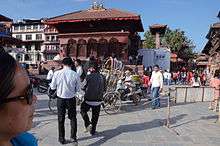
Kathmandu's Durbar Square is the site of the Hanuman Dhoka Palace Complex, which was the royal Nepalese residence until the 19th century and where important ceremonies, such as the coronation of the Nepalese monarch, took place. The palace is decorated with elaborately-carved wooden windows and panels and houses the King Tribhuwan Memorial Museum and the Mahendra Museum. It is possible to visit the state rooms inside the palace.
Time and again the temples and the palaces in the square have gone through reconstruction after being damaged by natural causes or neglect. Presently there are less than ten quadrangles in the square. The temples are being preserved as national heritage sites and the palace is being used as a museum. Only a few parts of the palace are open for visitors and the Taleju temples are only open for people of Hindu and Buddhist faiths.
At the southern end of Durbar Square is one of the most curious attractions in Nepal, the Kumari Chok. This gilded cage contains the Raj Kumari, a girl chosen through an ancient and mystical selection process to become the human incarnation of the Hindu mother goddess, Durga. She is worshiped during religious festivals and makes public appearances at other times for a fee paid to her guards.
Gallery
Earthquake damage
On 25 April 2015, an earthquake with an estimated magnitude of 7.9 (Mw) hit the region and severely damaged the Square, reducing several buildings to rubble.[2][3]
See also
References
- ↑ Nepal Handbook by Tom Woodhatch
- ↑ "'Before' & 'After' images of Nepal's key landmarks show scale of devastation (PHOTOS)". 26 April 2015. Retrieved 26 April 2015.
- ↑ "Nepal landmarks flattened by the quake". BBC News. Retrieved April 25, 2015.
Coordinates: 27°42′14.67″N 85°18′25.5″E / 27.7040750°N 85.307083°E
| Wikimedia Commons has media related to Durbar Square. |



